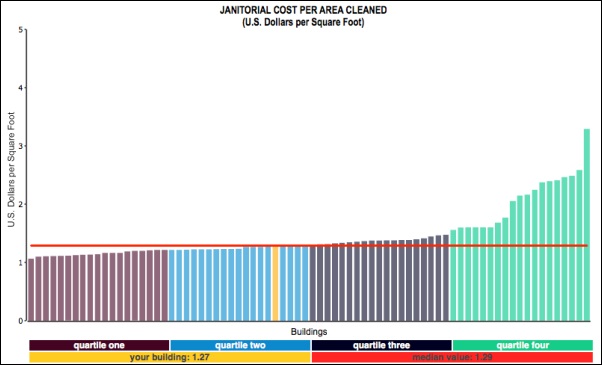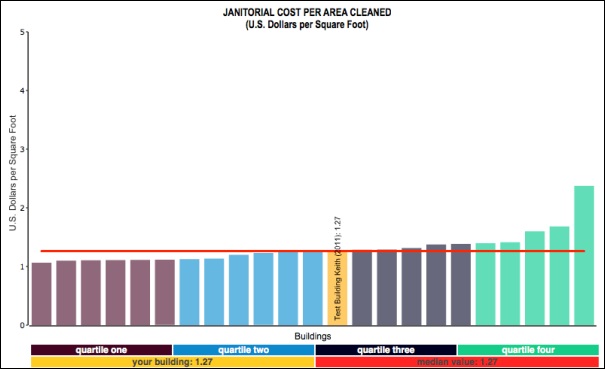Many FMs participate in benchmarking programs only to find that they have difficulty developing good comparisons for their facility type. Having access to ample data with good filter sets is key to making the right comparisons. Here are a few examples to show the value that filters can add to the analysis of your benchmarking data.
For example, if you are comparing your facility’s janitorial costs you might not know which filters are the most relevant. Here are some examples to illustrate which filters can make a difference.
We might want to see how the size of a facility impacts janitorial costs. Larger facilities may have a scale factor that results in lower costs so we may want to look at just facilities that are larger than 600,000 GSF (gross square feet).

Filters: Type of facility: office, greater than 600,000 GSF
Provided courtesy of FM BENCHMARKING.
The median cost (shown by the red line in Figure 1, which is where the second and third quartile intersect, is $1.25 per cleanable square foot with a sample size of 496 buildings. Our facility is shown in yellow with a janitorial cost of $1.27 per cleanable SF, it is near the lower (left) end of the third quartile.
What happens to our ranking if we compare our costs with only those companies using a represented (union) work-force. Most FMs would expect that a represented work force costs more and in this filtered example of 76 sites that is correct. According to this filter the median cost of a union represented workforce is slightly higher at $1.29 per cleanable SF (as the less costly buildings fell out of the comparison), so our ranking appears to improve by “moving” to the high (right) end of the second quartile (in reality, our building didn’t really improve—but is seemed to move because some better-performing buildings are no longer on the graph). This is clearly a much more accurate benchmark for our building.

Filters: Type of facility: office, greater than 600,000 GSF, contractual arrangement: Union
Provided courtesy of FM BENCHMARKING.
In the next example (see Figure 2), we take the same facility and same filters but add an age filter for those in our age category: 4-10 years. So instead of a sample size of 76 facilities without the age filter, we now have a sample size of 23 with the age filter. This is still an adequate sample size for good comparisons.

Filters: Type of facility: office, greater than 600,000 GSF, contractual arrangement: Union, age 4-10 years
Provided courtesy of FM BENCHMARKING.
Note that the median cost with the age-filtered sample is $1.27 per gross square foot which is a little lower than the non-age filtered example in Figure 3. This makes sense as we would expect newer facilities to have a lower cleaning cost than older facilities
Conclusions
Some things we’ve learned from applying various filters in our example that may affect management’s focus:
- There are slightly higher costs for a union workforce. This may not apply to all facilities but in our example it does appear that union issues have some influence on costs.
- We would expect the age of the facility to have some impact cleaning costs and in this example, the median costs do decline. Not a large amount but it is clear that newer buildings may be easier to clean.
This can help management better understand your building’s performance and result in more reasonable expectations.
As you can see filters are powerful tools to enhance your benchmarking value. By applying filters that are appropriate to the benchmarking metrics under consideration, you can enhance the value of the process and be sure you are making valid comparisons.